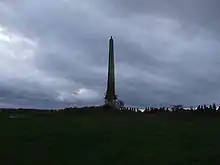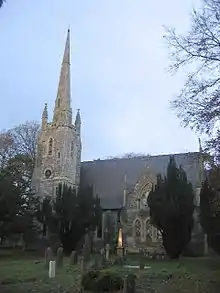Hockley Heath
Hockley Heath is a village and civil parish in the Metropolitan Borough of Solihull, West Midlands, England. The parish is to the south of the West Midlands conurbation, 12 miles (19 km) southeast of Birmingham 5.5 miles (8.9 km) from Solihull and 12.5 miles (20.1 km) north of Stratford-upon-Avon. The village forms part of the border with Warwickshire to the south. Until recently, as well as Hockley Heath village (which is at the extreme south-eastern corner of the parish), it included Cheswick Green, Dickens Heath, Tidbury Green, Salter Street, and Whitlock's End. However following a community governance review, on 31 March 2009 the former Hockley Heath Parish Council was abolished and on 1 April 2009 four new parish councils were created. The new parishes follow the old ward boundaries for the Hockley Heath Parish and each parish now has a parish council. According to the 2001 census, the parish had a population of 6,771, being measured at the 2011 Census as 2,038.[1]
| Hockley Heath | |
|---|---|
 The War memorial, Hockley Heath | |
 Hockley Heath Location within the West Midlands | |
| Population | 2,038 (2011 Census) |
| • London | 112 mi (180 km) |
| Metropolitan borough | |
| Metropolitan county | |
| Region | |
| Country | England |
| Sovereign state | United Kingdom |
| Post town | SOLIHULL |
| Postcode district | B90-B95 |
| Dialling code | 01564 |
| Police | West Midlands |
| Fire | West Midlands |
| Ambulance | West Midlands |
| UK Parliament | |
| Website | https://www.hockleyheathparishcouncil.org.uk/ |
History

Historically part of the parish of Hampton in Arden, the earliest reference here is to Nuthurst, situated south of the present day village. Dugdale found no mention of it before the reign of Henry III (1216–72)[2] but it has been identified with the woodland 'aet Hnuthyrste' given with Shottery to Worcester Cathedral by Offa c. 705.[3] Werfryd, Bishop of Worcester, in 872 granted to Eanwulf, the Kings thane, land at Hnuthyrst for four lives, with reversion to the monastery of Stratford. After the Norman Conquest the name usually appeared as Notehurst, but gradually reverted to its present and original spelling. Hockley Heath first appeared in the 13th century.[4] It was part of Hampton-in-Arden, and 1/5 knight's fee in Nuthurst was held of Niel de Mowbray c. 1230 and of Roger de Mowbray in 1242. The overlordship descended in this family, being held by Roger de Mowbray at his death in 1297, and by John Mowbray, Duke of Norfolk, in 1432.[3] After the Mowbrays it passed to the Montforts, Hastings and then to the Trussells and it was Sir William Trussell of Nuthurst who informed Edward II of his disposition in favour of his son.[2] By the 18th century it had passed to the Archers of Umberslade Hall and Lord Archer raised a 70 feet (21 m) limestone block obelisk on the estate in 1749.[5] The reason for this is unclear, possibly to celebrate his elevation to the peerage or just, as was the fashion during that period, as a folly.[4] However, according to local folklore it is said to mark the passing of a favoured horse, which is buried beneath it.
Until 1837, Hockley Heath had neither a church nor school. To remedy this, Umberslade resident and Whig MP for Warwick, Edward Bolton King, gave land for the building of a chapel on Orchard road and a school. The school building still stands on the end of School Road and is now used as an offices for John Shepherds estate agents.
Local industrialist and politician, Mr G. F. Muntz instigated the building of Umberslade Baptist church and adjoining Baptist school in 1876 and in 1892, the institute, later renamed King George VI Memorial Hall.
In 1913, the old school was closed and a new council school was built for 120 pupils from the old school and now closed Baptist school. The school is now Hockley Heath Primary Academy.
The village was attacked during the First World War when Zeppelin L 62 bombed the village during an attempted raid on Birmingham but heavy anti-aircraft fire prevented the airship from getting near the city centre.[6]
The sporting life of the village increased in the 1920s with the acquisition of land for recreation. This was due to the enterprise and generosity of Mr Harry Mould of Hockley House and grants from Warwickshire and National Playing Fields Associations, Carnegie trustees and by money raising events. Several hundred pounds was raised by Mr Mould, who acquired a Rhode car, value £235, and took it around the country inviting people to subscribe one shilling to the Recreation Ground Fund. The car was raffled at a concert held at the institute on 3 November 1923[7]
During the Second World War, the village had an air station called RAF Hockley Heath. The station opened in 1941 and closed in 1948. The airfield was situated on the Stratford Road opposite what is now Box Trees. The land is currently used for farming.
In 1978, the Memorial Hall was modernized, thanks to the generosity of the adjoining Men's Social Club, and is now run by this organisation.
Governance
Following then creation of the new parish an by an uncontested election on 4 June 2009 the following 5 councillors were elected to the Parish Council, Paul Edward Afford, Stu Barbour, Christopher John Lang, Peter Trengrove Rayson, Assunta Maria Vernon and the chairman, Peter Rayson.[8] Hockley Heath is part of the Dorridge and Hockley Heath ward of Solihull Metropolitan Borough Council and is represented by Mayor Ian Courts and Councillors Andrew Mackiewicz and Ken Meeson all of the Conservative party.[9] Nationally, it is part of the constituency of Meriden whose Member of Parliament since 2019 is Saqib Bhatti of the Conservative party. Prior to Brexit in 2020, it was included in the West Midlands electoral region of the European Parliament.
Notable landmarks


The ecclesiastical parish of Nuthurst cum Hockley Heath was formed in 1878 with the addition of the modern village of Hockley Heath from Tanworth. It lies for the most part between two roads from Henley-in-Arden to Birmingham which meet in the extreme north of the civil parish, where the church of St. Thomas, designed by John Cotton, a red-brick structure in the Early English style, was built in 1879[10] and consecrated on 30 June 1880, having cost £2,500. It was dedicated to St Thomas, as a compliment to Thomas Burman, of Warings Green, who, as the chief subscriber, laid the foundation stone in 1879.[4]
The village also has a second, now redundant church called Umberslade Baptist Church. The church was commissioned by George Frederick Muntz junior, the son of George Muntz, the industrialist and MP for Birmingham. It was designed by the Birmingham architect George Ingall and building was completed in 1877 in Umberslade Park, the estate of Umberslade Hall, Muntz's country seat.
Situated at the junction of the A3400 Stratford on Avon to Birmingham Road and the B4439, known as the Old Warwick Road is the War Memorial to those killed during the two World Wars.

The village is served by a number of pubs and restaurants, notably the Wharf Tavern, a firm favorite among both local residents and tourists. It underwent an extensive refurbishment in December 2019.
The Hockley Heath Recreation Ground is situated on the Old Warwick Road. It has a children's play area, a multi-use games area and 2 full-size football pitches. In 2014 a new BMX track was built, funded by the village fete committee. The recreation ground is used for major village events such as The village Fete, Bonfire Night and Proms in the Park. There is also a Pavilion which is used by local community groups such as the church, beavers, cubs, scouts, an under 3s club and local football teams. The venue is managed by the Parish clerk.
Transport links
The village is situated on the main A3400 Birmingham to Stratford Road, 2.5 miles (4.0 km) south of junction 4 of the M42 motorway affording links to London and other major cities, whilst 2 miles (3.2 km) south of the village there is a junction off the southbound carriageway of the M40 motorway.
The village is on the route of bus services X20 which runs between Birmingham and Stratford-upon-Avon. Additionally service S3 links the village to Solihull via Dorridge. Dorridge Station is the nearest railway station to the village at 2 miles (3.2 km) away with local connections to Solihull, Birmingham and Warwick and main line connections to London Marylebone on Chiltern Railways.
Nearby villages include Earlswood, Lapworth, Kingswood, Baddesley Clinton, Tanworth-in-Arden and the large village of Dorridge.

The Stratford-upon-Avon Canal runs through the village and Hockley Heath Wharf, situated to the rear of The Wharf Public house, meant it became one the Arden villages which later became a convenient stopping off point for users of the canal. The canal, which runs from Kings Norton, was navigable as far as Hockley Heath by 1798, the remaining link to Stratford being opened by 1816. Hockley Wharf served the surrounding area and non-perishable goods were unloaded there, including timber, lime, coke, coal, cement, bricks and salt. The last commercial load was brought into the wharf on Christmas Eve, 1929.[11]
The village was formed as a horse changing point on the 25-mile journey between Birmingham and Stratford-upon-Avon. A public house once called "The Nag's Head" still stands next to the place where the stables are thought to have once stood.
Education
Hockley Heath Primary Academy is situated on School Road, Hockley Heath, Solihull, West Midlands, B94 6RA
| School | Compulsory education stage | School website | Ofsted details |
|---|---|---|---|
| Hockley Heath Primary School | Primary | http://www.hockley-heath.solihull.sch.uk/ | Ofsted details for unique reference number 104064 |
In 2020, The Real Schools Guide ranked Hockley Heath Primary Academy as the 9th best primary school in Solihull.[12]
Local secondary schools include Tudor Grange Academy Solihull, Arden Academy, Henley-in-Arden School and St. Peter's Catholic School.
Sport
The village has a local youth football club named Hockley Heath Football Club. The club was founded in September 2011 and as of 2020 has teams across eight age groups from under 6 to under 13. The teams play matches at the Hockley Heath Recreation ground. The club badge contains the notable local landmark, the War Memorial.
There is an adults Sunday league football team called Hockley Heath Dynamos. The comedian Jasper Carrott played for the club during the 1970s.
Racing Blythe Football club also play their matches at the recreation ground.
The Hockley Heath Bowling club play their matches at the bowling green on the recreation ground.
There is also a Hockley Heath Cricket Club established in 1888.
References
- "Civil Parish population 2011". Retrieved 16 December 2015.
- The Antiquities of Warwickshire, William Dugdale, 1656
- A History of the County of Warwick: Volume 3
- In the Forest of Arden, John Burman, 1948
- Nicholson, Jean et al: The Obelisks of Warwickshire, page 20. Brewin Books, 2013
- "Sitesafe UXO Desk Study". Birmingham City Council. Retrieved 21 April 2012.
- "Towns and Villages Around Solihull | Hockley Heath". www.visitoruk.com. Retrieved 20 January 2020.
- Notice of Election Accessed 17 January 2010
- "Archived copy". Archived from the original on 19 January 2008. Retrieved 20 January 2011.CS1 maint: archived copy as title (link)
- Nikolaus Pevsner and Alexandra Wedgwood, The Buildings of England, Warwickshire, 1966, ISBN 0-14-071031-0
- "Hockley Heath History". solihull.gov.uk. 17 January 2020. Retrieved 17 January 2020.
- Chamberlain, Zoe (13 January 2020). "The best primary schools in Solihull". birminghammail. Retrieved 17 January 2020.
External links
![]() Media related to Hockley Heath at Wikimedia Commons
Media related to Hockley Heath at Wikimedia Commons